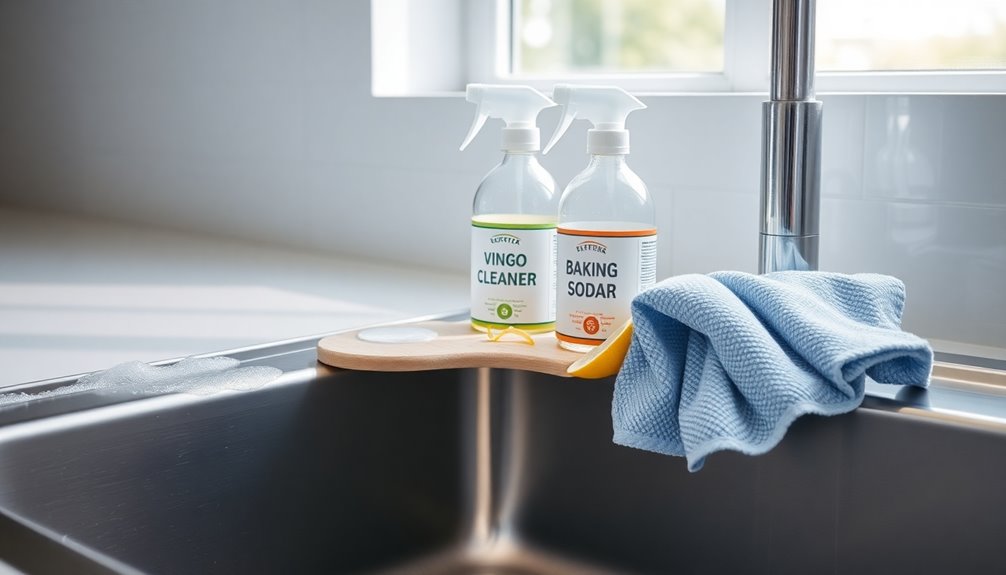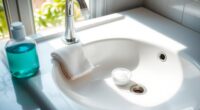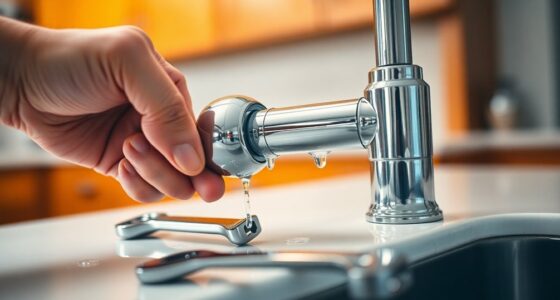To disinfect your sink without bleach, start by cleaning it with dish soap and a sponge. Next, try natural alternatives like a mixture of vinegar and hydrogen peroxide—just spray and let it sit for 30 seconds before rinsing. You could also use baking soda combined with vinegar for a fizzing clean. Just a quick weekly disinfecting practice can keep your sink germ-free. If you want to know more methods and tips, keep exploring!
Key Takeaways
- Use hydrogen peroxide by spraying it on the sink and letting it sit for 30 seconds to effectively eliminate germs.
- Combine equal parts white vinegar and water in a spray bottle for a natural disinfectant option.
- Mix baking soda with vinegar for a powerful fizzing reaction that cleans and disinfects the sink.
- Scrub the sink with halved lemons for natural cleaning and deodorizing benefits.
- Regularly spray the sink with vinegar after each use to prevent buildup and maintain hygiene.
Why Disinfecting Your Sink Is Important
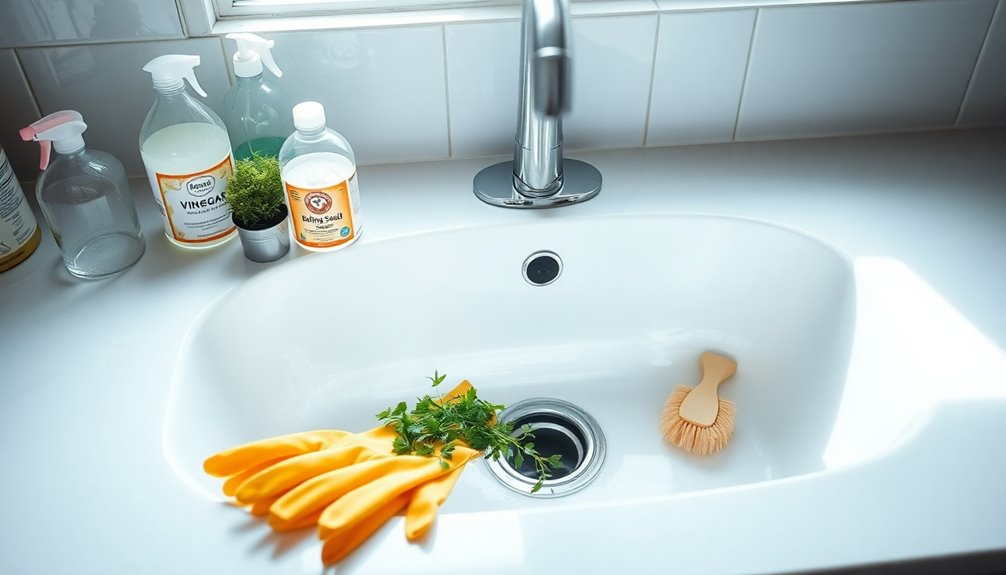
While you mightn't think twice about the cleanliness of your sink, disinfecting it's essential for your health.
Kitchen sinks are among the germiest surfaces in your home, often harboring harmful bacteria that can lead to foodborne illnesses like E. Coli and Salmonella. These pathogens thrive in damp, food-splattered environments, making regular disinfection vital.
By disinfecting your sink at least once a week, you considerably reduce the risk of cross-contamination, preventing bacteria from transferring to sponges, cutlery, and food. Maintaining a sanitized environment contributes to overall kitchen hygiene, ensuring safe food preparation and minimizing the spread of germs.
Without proper disinfection, germs can linger, increasing the likelihood of infections and health issues in your household.
Step 1: Clean Your Sink
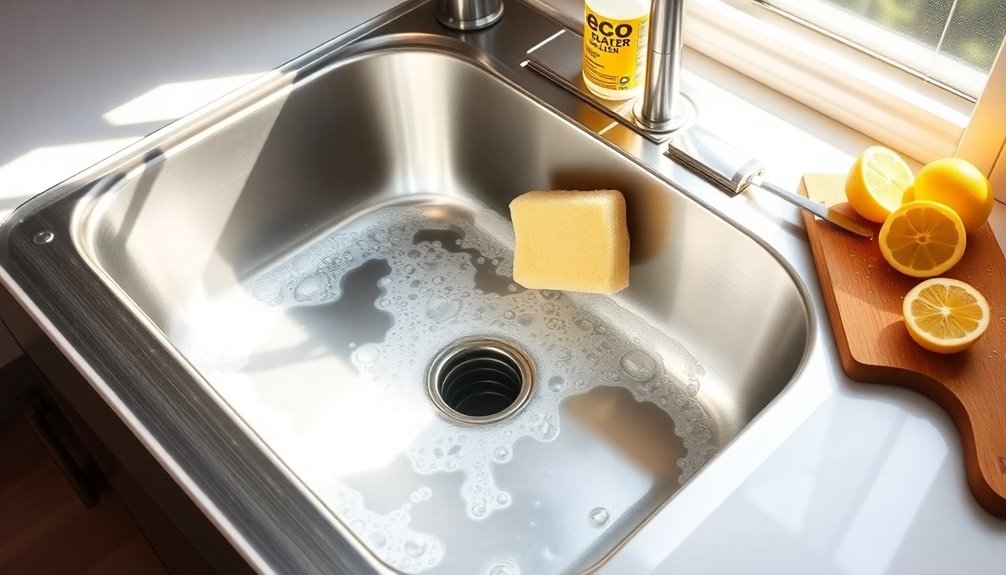
Start by clearing your sink of any food scraps and debris to guarantee an effective cleaning process.
Once your sink is empty, grab some dish soap and a sponge to scrub the sink thoroughly.
Focus on removing all dirt and grime, especially in those hard-to-reach areas where food particles tend to hide.
If you have stainless steel sinks, remember to wipe in the direction of the grain to avoid scratches.
After scrubbing, it's crucial to rinse the sink thoroughly with water to eliminate any soap residue.
Make sure there's no lingering dish soap, as it can interfere with the next steps.
Finally, allow your sink to dry completely before moving on to the disinfection step for ideal results.
Step 2: Disinfect the Sink
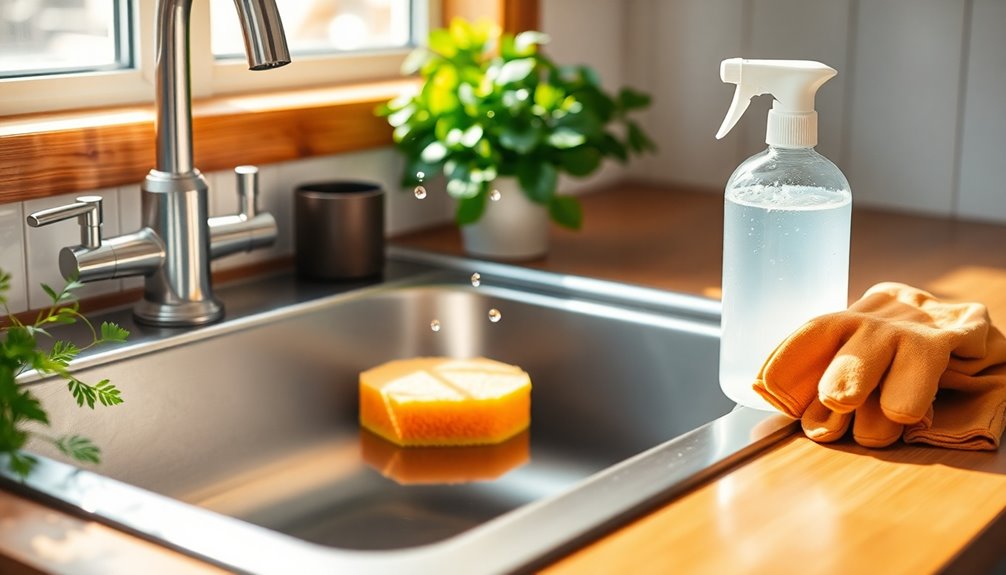
Once your sink is clean and dry, it's time to disinfect it effectively. Grab some hydrogen peroxide and either spray it evenly across the sink's surface or dampen a cloth with it for wiping.
Let the hydrogen peroxide sit for at least 30 seconds to eliminate germs and bacteria. For added scrubbing power, take a sponge and gently scrub all areas of the sink, ensuring you reach every corner.
This antibacterial action boosts hygiene and helps keep your sink safe from harmful microbes. After scrubbing, rinse the sink thoroughly with water to remove any remaining hydrogen peroxide and grime.
Aim to disinfect your sink at least once a week to maintain peak hygiene and prevent bacterial buildup.
Method #1: Vinegar and Hydrogen Peroxide
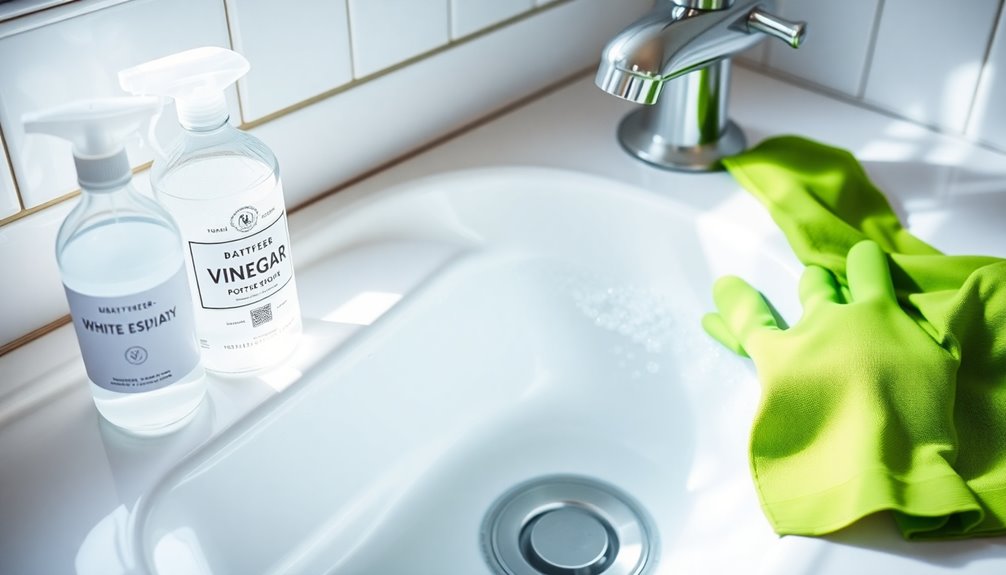
One effective method to disinfect your sink without bleach is by using vinegar and hydrogen peroxide.
Start by spraying your kitchen sink with vinegar, which helps break down grease and grime. Let it sit for a few minutes before rinsing.
Next, spray hydrogen peroxide over the sink, allowing it to sit for at least 30 seconds. This step guarantees effective germ elimination, targeting harmful bacteria without the risks associated with bleach.
Remember, don't mix vinegar and hydrogen peroxide in the same container, as this can create harmful gases.
This method is safe for various sink materials, and using it weekly can greatly improve your kitchen hygiene by reducing bacteria levels.
Method #2: Baking Soda and Vinegar
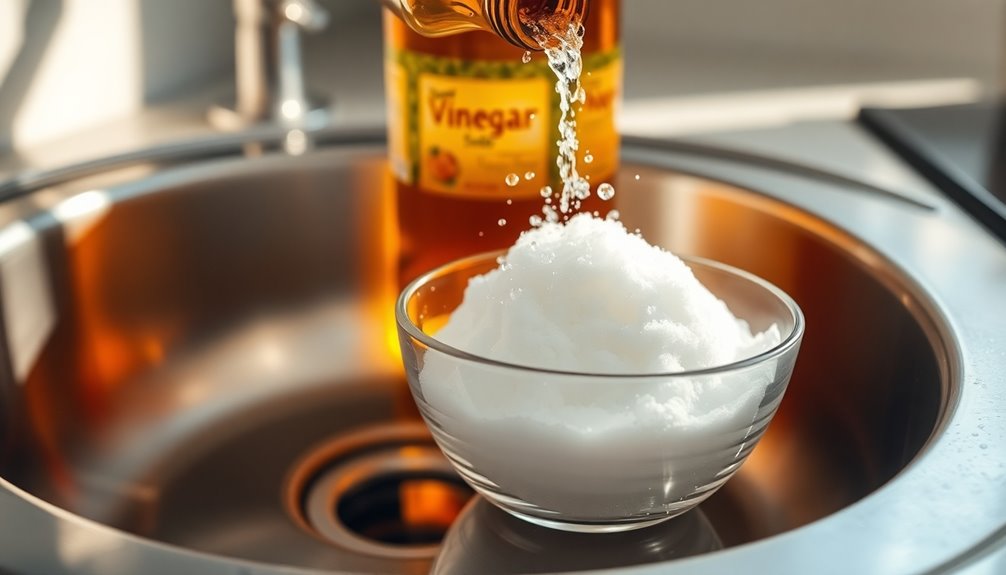
Using baking soda and vinegar is a fantastic way to disinfect your sink while keeping it safe for all surfaces.
When combined, these ingredients create a powerful fizzing reaction that effectively tackles grime and stains.
Plus, you won't have to worry about harsh chemicals harming your sink's finish.
Effective Cleaning Reaction
While many cleaning methods can be effective, the combination of baking soda and vinegar stands out for its ability to create a powerful fizzing reaction that breaks down grime and bacteria in your sink. This natural cleaning alternative not only disinfects but also neutralizes odors. Additionally, for a more aromatic experience, consider incorporating essential oils like tea tree oil, which has antibacterial properties.
| Step | Action |
|---|---|
| 1. Sprinkle | About 1/2 cup of baking soda evenly |
| 2. Pour | 1 cup of vinegar over the baking soda |
| 3. Wait | Let the mixture fizz for 10-15 minutes |
| 4. Scrub and Rinse | Gently scrub, then rinse thoroughly |
Using this effective method, you'll achieve a clean sink without harsh chemicals. Enjoy a fresh, disinfected space that's safe for your home!
Safe for All Surfaces
Baking soda and vinegar not only create a powerful cleaning reaction but also offer a safe solution for all sink surfaces. This method is perfect for disinfecting without harsh chemicals, making it safe for porcelain, stainless steel, and more.
To start, sprinkle baking soda over your sink, then spray or pour vinegar on top. Let the mixture sit for a few minutes to effectively lift grime and disinfect. After scrubbing, rinse thoroughly with warm water to remove any residue.
This combination not only eliminates bacteria but also neutralizes odors, leaving you with a fresh-smelling sink. Regular use can help prevent mold buildup, contributing to a healthier kitchen environment. Additionally, incorporating natural anti-inflammatory remedies into your cleaning routine can enhance your overall health and well-being.
Enjoy a gleaming, sanitized sink with this simple, safe method!
Using Natural Cleaning Alternatives
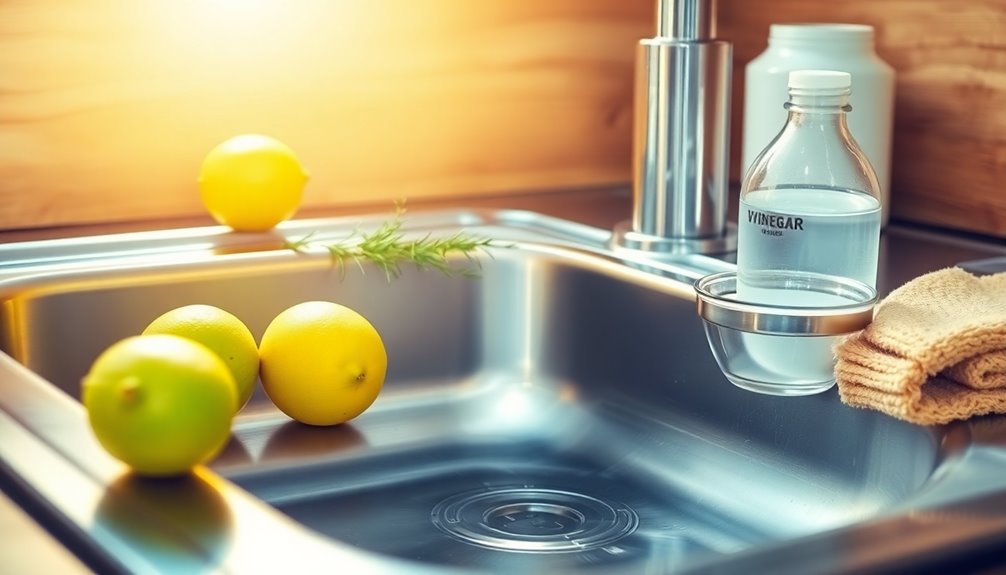
If you're looking to disinfect your sink without resorting to bleach, natural cleaning alternatives are a great option. You can mix equal parts white vinegar and water in a spray bottle to disinfect your kitchen sink and tackle stubborn grease.
For a powerful combination, try baking soda and vinegar; their fizzing reaction helps clean and disinfect surfaces safely. Hydrogen peroxide is another non-toxic choice, effectively eliminating germs without harming your family or pets.
Don't forget lemon juice! Scrubbing the sink with halved lemons not only cleans but also deodorizes.
Regular cleaning with these natural alternatives, like spraying vinegar after each use, can maintain clean kitchen sinks and prevent bacteria buildup effortlessly.
How Often to Disinfect Your Sink
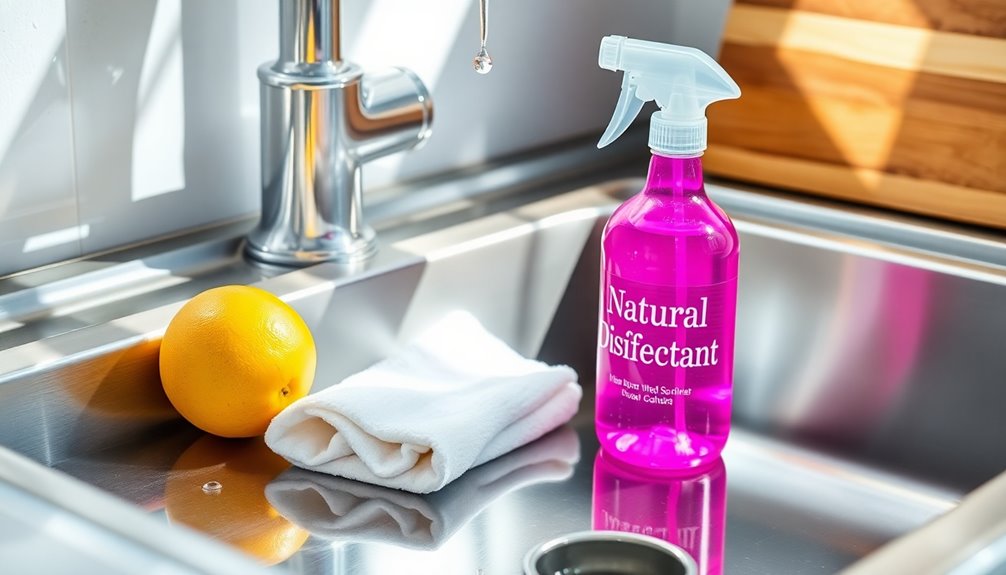
Disinfecting your sink at least once a week is essential for keeping your kitchen safe from germs and bacteria. If you cook frequently, you might need to clean your sink more often to maintain hygiene standards. Kitchen sinks are among the germiest places in your home, so regular disinfection is crucial for food safety. A clean sink plays a significant role in preventing the spread of harmful bacteria like E. Coli and Salmonella.
| Frequency | Reason |
|---|---|
| Weekly | Combat germs and bacteria |
| After cooking | Maintain food safety |
| Daily (if needed) | Enhanced hygiene |
| Special occasions | Prevent contamination |
Maintaining Your Sink Between Cleanings
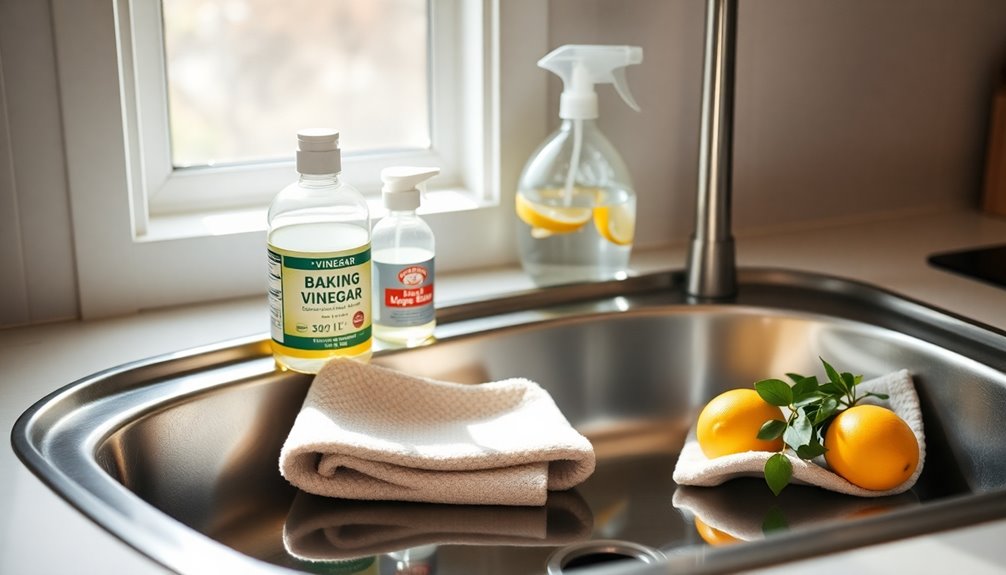
To keep your sink in top shape between cleanings, make it a habit to spray it with white vinegar after each use. This simple step helps deter buildup and maintain cleanliness.
Here are three additional tips to follow:
- Dry the sink thoroughly after each use to prevent moisture and food stains.
- Avoid leaving dishes in the sink for extended periods to minimize contamination and bacteria without proper cleaning.
- Wipe down with a damp cloth regularly to remove surface grime and keep clean sink drains.
For an extra boost, consider using a natural disinfectant made from baking soda and vinegar and water. This combo will help keep your sink sanitized and fresh until your next deep cleaning!
Cleaning Different Types of Kitchen Sinks
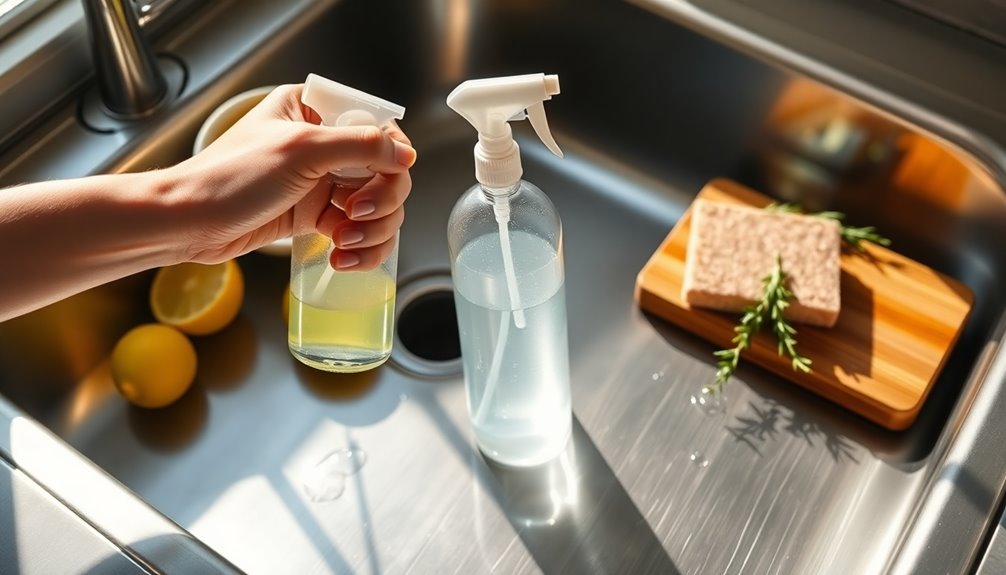
When it comes to cleaning different types of kitchen sinks, knowing the right approach for each material is essential for maintaining their appearance and longevity.
For porcelain sinks, use non-abrasive cleaners and avoid harsh chemicals like bleach to prevent scratches.
Stainless steel sinks can benefit from baking soda, vinegar, and warm water, but stick to non-corrosive disinfectants like hydrogen peroxide.
Copper sinks need gentle cleaning methods and regular waxing to keep them shining.
For brass sinks, opt for pH-neutral cleaners to avoid corrosion and preserve their finish.
Each sink type requires specific cleaning techniques and products, so be certain to tailor your approach to guarantee their lasting beauty and durability.
Frequently Asked Questions
How Do You Disinfect a Sink Naturally?
To disinfect your sink naturally, mix equal parts white vinegar and water in a spray bottle.
Spray the solution on the sink, letting it sit for a few minutes before wiping it down.
For stubborn stains, sprinkle baking soda on the surface, then spray with vinegar for a fizzy reaction.
You can also use hydrogen peroxide by spraying it directly and letting it sit for at least 30 seconds.
Rinse thoroughly for a fresh finish!
How to Disinfect Without Bleach?
To disinfect without bleach, you've got several effective options.
Try spraying hydrogen peroxide on surfaces and letting it sit for 30 seconds before rinsing. You can also mix vinegar with water in a spray bottle to eliminate bacteria.
For a natural scrub, combine baking soda and lemon juice into a paste.
Remember to regularly disinfect your surfaces to maintain a clean and safe environment, ideally at least once a week.
How to Disinfect a Sink After Raw Chicken Without Bleach?
Picture a gleaming sink, free of any remnants from raw chicken.
After you've scrubbed away the visible bits, grab a spray bottle filled with 3% hydrogen peroxide. Mist it over the surface, letting it soak for at least 30 seconds.
As you scrub with a sponge, feel confident knowing you're destroying harmful bacteria. Rinse thoroughly, washing away any traces.
For added peace of mind, make this a weekly ritual to keep your kitchen safe.
How to Clean a White Sink Without Bleach?
To clean your white sink without bleach, start by mixing baking soda and dish soap into a paste.
Apply it directly to any stains and scrub gently with a sponge.
For tougher stains, sprinkle baking soda and spray with white vinegar, letting the fizz lift the grime.
You can also use lemon juice for a natural clean—just scrub with a lemon half.
Rinse thoroughly afterward to keep your sink sparkling and fresh!
Conclusion
To summarize, safeguarding your sink's surface is simpler than you might think. By choosing clever, chemical-free cleaning methods, you can create a sanitary space without the harshness of bleach. Your diligence in disinfecting daily and maintaining regularly will lead to a sparkling, safe sanctuary for your family. So, stay savvy, seize the solutions, and sparkle your sink with sustainable strategies that shine!
